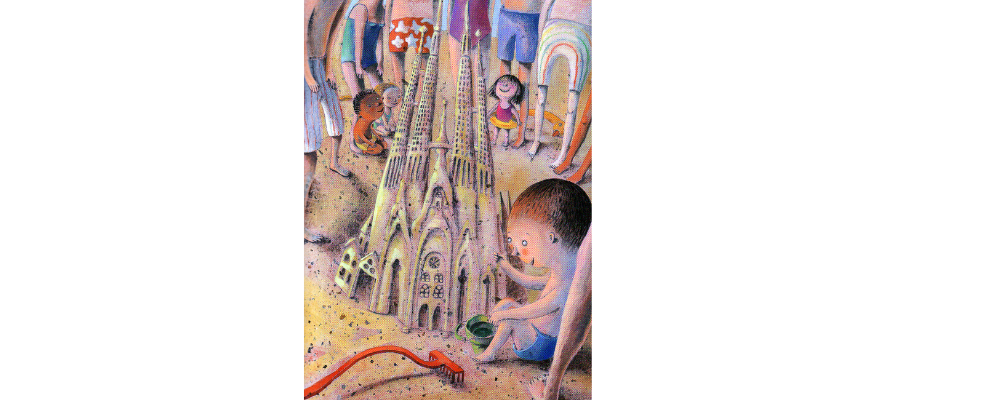Although the family and social environment are influential elements in the emotional and social development of children, the way they express their feelings is different from adults.
Although the family and social environment are influential elements in the emotional and social development of children, the way they express their feelings is different from adults. Similarly, the ways in which children express their feelings vary according to the behavior of their addressee. Eva Montanari's Carlo Castlecrusher is also one of the examples that draw the reader’s attention to some emotions which are the hidden reasons of some reactive behaviors of children.
The characters of the narrative are Carlo who watch them from afar, and three children, who build sand castles on the beach, namely; Ziyad, Suzi, Mei. Carlo crushes the castles made by these three friends. Ziyad throws sand to Carlo because he ruins their castles, and Suzi starts crying, while Mei quietly leaves. Later on, a new child named Sebastian joins them and starts building "extraordinary" sand castles. Everyone watches Sebastian with admiration. Carlo wants to crush these castles too but his father takes him home because the time was late. The next day Sebastian continues to build "extraordinary" sand castles in front of a large crowd who admires him. Carlo rushes through the crowd, and this time he destroys the castles. But no one reacts to Carlo. When Carlo leaves that place because there was no response to him, he crashes his father. His father tells Carlo that if he continues acting like that he will never make friends. The next day, Carlo turns out to be a different person as if a magic wand touches him, and comes back to the shore to build sand castles. This time Carlo is being watched with admiration. Ziyad, Suzi, Mei, Sebastian and Carlo's father applauds Carlo sincerely. Thus, Carlo the Castle-crusher becomes Carlo the Castle-builder.
In the narration, we can say that negative reaction of Ziyad, Suzi, and Mei to Carlo when he broke the castles is still a way of creating communication with Carlo. Responding to Carlo’s vigorous behavior reinforces this attitude in a negative sense and makes it inevitable that he reacts again in a pettish manner when a different situation occurs. Indeed, the fact that Carlo also crushes the castles of Sebastian, who was later articulated in the narrative, and it shows that this negative reinforcement is supported. From another point of view, pettishness means emotional reactions such as harm, anger and aggressive behavior. Pettishness is in fact an expression of an emotion, and it is the instability between emotion and behavior. There may be many reasons causing this situation. In Carlo Castle-crusher, the reason for this situation is not clearly described. However, one of the possible reasons may be the inability of Carlo to express himself. Therefore, even if Carlo wants to communicate with other children and make friends, he did not know what exactly to do. At this point, a confusion arises between Carlo's emotions and behavior, and this confusion results in the destruction of the castles of the three children. The negative reaction of these children causes a positive feeling in Carlo on his self-expression and making friend. The fact that Sebastian did not react to Carlo, who destroyed his castles, transforms a positive situation into a negative one –when his father tells him that he cannot make friends if he continues to do that. As a result, Carlo evaluates his feelings and thoughts, and decides that creating communication and friendship will not be achieved by crushing the castles. This transformation is also supported by picturing Carlo who thinks by himself when returning home on the shoulder of his father's. The visual illustrating that Carlo who is applauded by his father, Ziyad, Mei, Suzi and Sebastian after building castles, is a reflection of a positive support of Carlo's changing behaviour.
Another phenomenon underlying Carlo's aggressive behavior is the initial acknowledgement of not being able to control the emotions and not knowing another way to solve the problems. The role of parents is great in solving this problem. Parents can abandon their grudge and aggression by giving responsibilities to children who show offensive and aggressive behaviors, supporting them to join group work, praising their positive behavior, feeling of being loved, and so on (Özbey, 13). In the narrative, the father warning Carlo without criticizing him is the first step towards reducing Carlo's negative behaviors towards his friends. Then, Carlo builds sand castles on the beach, and his father applauds him. This positive support is the second step to diminish his negative behaviors.
As a result, though the narrator does not completely explain the underlying causes of Carlo's negative attitudes, it can be concluded that he may act in this negative manner due to the reasons mentioned above. At this point, the underlying factor in Carlo's "crushing castles" is defined as Carlo's desire to communicate with other children, but he does not know the right way to express this desire. In the narrative, the steps towards the abolishment of the negative situation by the narrator supports the predictions we have made. The narrative shows the way to communicate positively from the negative situation with a clear language. The character's transformation is obvious: From Carlo the Castle-crusher, to Carlo the Castle-builder!
Bibliography
Montanari, Eva. Kalebozan Karlo. Redhouse Kidz Yayınları, 2006.
Özbey, Saide. Okul Öncesi Çocuklarda Uyum ve Davranış Problemleriyle Başa Çıkmada Ailenin Rolü. Aile ve
Toplum, 11, 6, 22, 2010.

